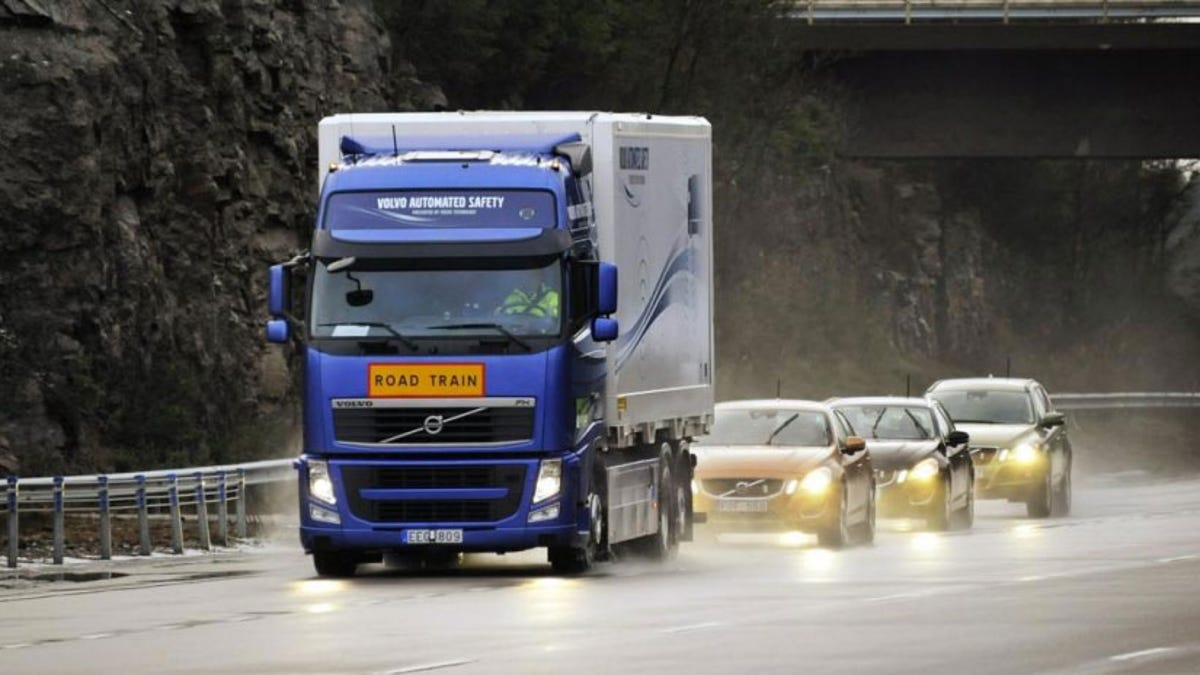Platooning: The future of freeways is lining up
Linking cars into a trainlike group can save fuel, fit more cars on the road, and potentially improve safety. A project in Europe shows it's not just a fantasy.

Editors' note: Be sure to catch the other stories in this package: on how Google's robo-cars mean the end of driving as we know it, on self-driving cars bristling with sensors, and on smart transport grids.
What do you get when you combine packed freeways with the promise of self-driving cars? A mess, of course, and a technological challenge. One potential solution: a system called platooning that links vehicles in a high-efficiency group, like a train without the train tracks.
The idea has been around for years, but endowing cars with computing and communication smarts means it's moved into real-world testing. Perhaps the best example is a European project called Sartre (Safe Road Trains for the Environment) that tucked three autonomously driven Volvo cars into the slipstream behind a truck on real-world roads.
Platooning ultimately could mean that cars whizzing along at 75 miles an hour in a bumper-to-bumper train that dramatically increases the capacity of existing roads, said Richard Wallace, a researcher with the Center for Automotive Research.
Sartre began with today's road system, not a more distant sci-fi future in which every speed bump has an IP address. For example, it used a human driver in the lead vehicle. Because of that, Sartre needed to change only the vehicles involved, not the road infrastructure, said Stefan Solyom, a Volvo technical specialist involved in the Sartre project.
As cars enter or leave a Sartre platoon, they can be under the control of either a human driver or the car itself. Distances from one car to the next are computer-controlled, but steering can be either manual or automatic. The cars communicate with themselves and the lead truck using a variation of the 802.11p wireless network technology.
The result is a group of cars that get 20 percent better fuel economy, Solyom said.
Sartre chose to use a bus or a truck as a special lead vehicle for a several of reasons. First, professional drivers are safer than ordinary ones. Second, using special vehicles simplifies payment for the privilege of being in a platoon. Third, large vehicles block the wind for better group aerodynamics. Last, cars can always brake better than trucks, so there's no risk of the lead vehicle stopping more abruptly than trailing cars can.
You might think that a platoon would pack cars tightly together into a unit that can slip through the air with minimum resistance. In fact, it's better to separate vehicles with a larger gap -- though still only about a tenth as wide as the gap that traffic authorities recommend for human-controlled cars.
"There is a limit how close it is actually worth it to cruise," Solyom said. The optimum space: six meters, or about 20 feet.
The problem is that with closer distances, each car must accelerate and brake more frequently to maintain the right distance. "There is a limit where it is not worth it to follow closer because the fuel economy benefit you get from the aerodynamics, you lose from the actuation of acceleration and braking," Solyom said. And of course, safety becomes more of an issue as well, though it's not nearly as big a deal since all cars are in constant communication with the lead vehicle.
Platoons bring a positive side effect, too: they can ease the shock waves of acceleration and deceleration that propagate along roads. When a driver taps the brakes, the next driver often must tap a little harder because of the delay, then the third driver must tap a little harder, and so on.
A platoon, though, "will attenuate the shock waves," because the cars all travel as a unit and therefore don't amplify the shock waves.
Another, more obvious benefit is that more cars can be crammed onto the road. Sartre limited platoons to 10 vehicles so that platoons and ordinary traffic could intermix, without having to worry about blocked freeway exits.
Ultimately, platoons could liberate drivers from the tedium of driving.
"One of the main things with platooning is you could engage in secondary activities -- read e-mail, work, relax," Solyom said. But that's much more advanced than in Sartre's test, in which drivers still have responsibility for their own vehicles.
The Sartre project helped develop a payment mechanism not unlike buying tickets to ride public transit, with an online site to buy tickets for a platoon, Solyom said. You book a spot in a platoon ahead of time, then a back-office system tells you where and when to meet. When you arrive, helps the lead vehicle confirm you are an authorized member of the platoon.
What Sartre accomplished is only a start, of course. Plenty of serious complications remain -- for example, integrating with real road infrastructure and other drivers, improving automation so drivers can relax, getting rid of a reliance on a lead vehicle, letting cars spontaneously form platoons, overcoming regulatory barriers, and choosing whether to mark platoon-specific highway lanes.
So no, platooning is not ready for real-world use yet. But it's well on its way.

